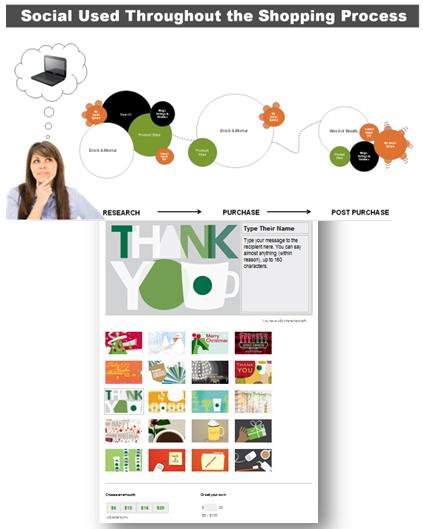 Earlier this week, Rosalina Lin-Allen, Delvinia’s Director of Client Strategy, hosted a complimentary webinar on the Canadian Social Shopper, sponsored by Tenzing.
Earlier this week, Rosalina Lin-Allen, Delvinia’s Director of Client Strategy, hosted a complimentary webinar on the Canadian Social Shopper, sponsored by Tenzing.
Social networks have experienced explosive growth in the last few years. Today, social networking is the number one activity on the Internet, accounting for 23 per cent of user’s time spent online (source: Nielsen, September 2011). Consumers are using social networking sites and features in all aspects of their lives, including shopping.
Roz outlined the following five steps that retailers and brands can take to meet the needs of these social shoppers.
Step 1 – Listen
Understand how your target audience interacts with your category and brand on social media in their shopping process.
One example is to map out the customer journey and understand what the projected adoption will be. According to our survey in AskingCanadians™, 38.1 per cent of consumers follow or friended a brand on a social media page.
Step 2 – Define Strategy
Identify the sweet spot for your brand and category. Establish key performance indicators along the way. Taking Starbucks for example, they identified the most social component of their offerings – gift cards – and are selling them in the Facebook environment. Within that environment, consumers can select a Facebook friend and send them a gift card, which the recipient can redeem in store using the code that comes along with the card. Consumers can also include a personalized message. What Starbucks did well here was focusing on things that made sense in the social environment, complementing other customer touch points that they have.
Step 3 – Cultivate the Community
Before you can sell to consumers, you need to have a fan base and audience you can reach out to. While social commerce may be a couple of years away, start cultivating your community now.
Today, the top three reasons Canadian consumers engage with brands are to:
- learn about discounts and deals
- find out about the latest products and events
- get opinions/advice from other consumers.
It’s really about providing what they need balanced with what makes business sense. For example, deals and promotions should be used in a limited way. When overdone, it does not provide an upside to the business.
Step 4 – Experiment
Keep trying new things. We need to give credit to 1-800-Flowers for being the first one out on f-Commerce and for continuing to refine their f-Commerce model. While experimenting, get customer input. Social media is a forum for two-way dialogue and customers are expecting dialogue so tap into that knowledge base.
Step 5 – Measure
Measure against the key performance indicators you have set up. After all, you can’t improve upon what you can’t measure. Measure based on the sales funnel approach. When you look at the customer journey, you want to identify the trigger points where they will be using social media and keep them moving along the sales funnel. So research into engagement into conversion into advocacy and so forth.
Looking ahead
The future social shoppers are a lot more social network savvy than the mainstream consumers today. For example, 85 per cent of teenage girls use their friends and peers as a source of trend information and 45 per cent seek the opinion of those same groups when purchasing clothing or footwear (source: eMarketer, Nov 2010). And the average number of Facebook friends that average Canadians between 13-24 have is 330, that’s 50 per cent more than the average Canadian who has 225 friends (source: Facebook, June 2011). So as you can see they are a lot more active on social networks and their purchasing behaviour is very different and a lot more amplified by social network technology.
You can view the recorded Canadian Social Shopper webinar here.
Don’t miss the two other pre-recorded webinars from our three-part Canadian Shopper series:
Canadian Mobile Shopper Webinar: How retailers and brands should approach mobile shopping. WATCH NOW
Canadian Multichannel Shopper Webinar: How retailers or manufacturers should effectively engage their multichannel shoppers. WATCH NOW